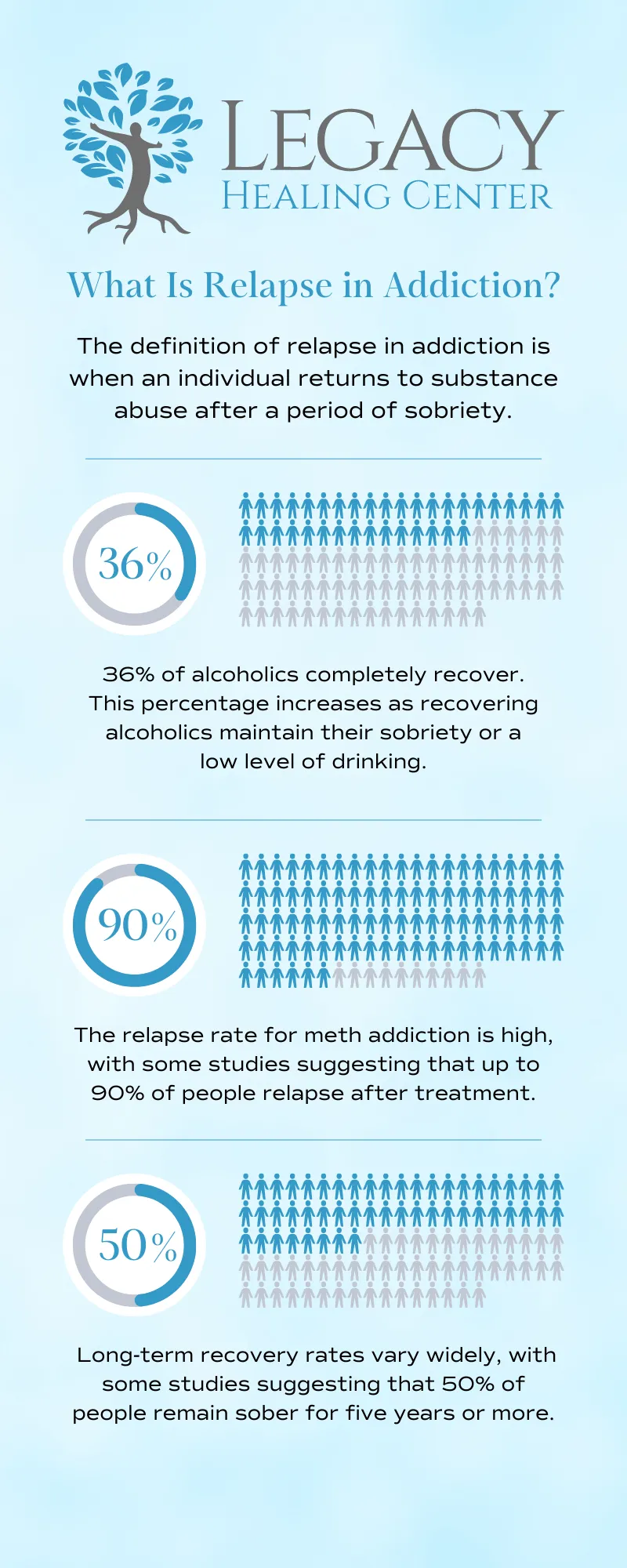
Relapse: What Percentage of Addicts Stay Clean?
You often hear about people attending drug or alcohol rehab repeatedly. It understandably can cause you to wonder what percentage of addicts stay clean. Before looking at the statistics, it is essential to know that recovering from alcohol or substance use disorder (SUD) typically involves a relapse.
Addiction is characterized by intense physical and psychological dependence, which makes it extremely difficult for individuals to stop using substances once they’ve started. Often beginning with subtle symptoms of substance abuse, the condition can escalate quickly, leading to a cycle that’s hard to break.
Choosing to seek treatment is a crucial step toward recovery, but it’s important to recognize that many people experience relapse even after completing a rehabilitation program. Below, we’ll take a closer look at what causes relapse and how it can be managed.
What Is Relapse in Addiction?
The definition of relapse in addiction is when an individual returns to substance abuse after a period of sobriety. It’s important to understand that a relapse doesn’t mean failure; instead, it’s an indication that the person may need more support or better Sobriety Life Hacks to stay on track with their recovery journey. It’s crucial to identify the triggers that cause relapse and develop coping mechanisms to deal with them. At our luxurious rehabs, we provide aftercare support programs to ensure that you stay clean after completing rehab.
What Does “Recovery” Mean?
At Legacy Healing Center, we believe that recovery means complete abstinence. However, for others recovery may vary between:
- Abstinence – Total cessation of alcohol and drug use.
- Moderation/Controlled Drinking – For some, this means returning to low-risk drinking levels.
- Functional Recovery – Regaining control over one’s life, relationships, and responsibilities, even if some alcohol or drug use persists.
These outcomes depend on multiple factors, such as the severity of addiction, co-occurring mental health conditions, personal motivation, and the quality of support and treatment received.
Factors That Influence Recovery Rates
Several factors significantly impact an individual’s likelihood of achieving lasting recovery:
- Type and duration of treatment (e.g., inpatient rehab, structured outpatient, addiction counseling, 12-step programs, medication-assisted treatment).
- Social support networks, including family involvement and peer support groups like Alcoholics Anonymous (AA).
- Mental health care for underlying conditions such as depression or anxiety.
- Socioeconomic factors, including employment and stable, substance-free housing.
Alcoholism, also known as Alcohol Use Disorder (AUD), is a chronic but treatable condition characterized by an impaired ability to stop or control alcohol use despite negative consequences. It can lead to severe physical, psychological, and social complications. However, the journey toward recovery, though challenging, is entirely possible with comprehensive treatment, strong support systems, and sustained commitment.
Recovery Statistics: What Do the Numbers Show?
A growing body of research provides hopeful data on recovery outcomes. According to findings from the National Institute on Alcohol Abuse and Alcoholism (NIAAA) and other long-term studies:
- Approximately 36% of individuals with AUD recover within the first year of seeking treatment. This includes both those who achieve complete abstinence and those who significantly reduce their alcohol intake to non-harmful levels.
- Over time, the chances of recovery increase substantially. For example, individuals who maintain sobriety for five years or more have an 85% chance of staying sober for life.
- One long-term study, the National Epidemiologic Survey on Alcohol and Related Conditions (NESARC), found that about 25–30% of people with AUD recover without formal treatment, typically referred to as “natural recovery” or “spontaneous remission.”
What Percentage of Meth Users Stay Clean?
Methamphetamine is a highly addictive stimulant drug that can cause severe physical and psychological damage. Long-term use of meth can lead to dependence (methamphetamine use disorder) making it challenging for individuals to quit without professional help. The relapse rate for meth addiction remains high, with some studies indicating that up to 90% of individuals may relapse after initial recovery. However, with a structured meth addiction treatment program- starting with meth detox and followed by comprehensive therapy – many people are able to stop using methamphetamine and maintain long-term sobriety.
Methamphetamine (commonly known as meth, pink meth, crystal, or ice) is a potent central nervous system stimulant that can be profoundly addictive. Chronic meth use leads to significant alterations in brain chemistry, particularly affecting dopamine regulation, which is closely tied to pleasure, motivation, and reward. These changes contribute to the intense cravings and high relapse rates seen in individuals attempting to quit.
The Challenge of Recovery: High Meth Relapse Rates
Methamphetamine addiction is notorious for its high relapse rates, which are among the highest across all substance use disorders. Research indicates meth relapse rates:
- Between 88–90% of meth users relapse within the first year after initial detox if no continued treatment or aftercare is provided.
- A 2010 study published in Addiction found that only about 13% of methamphetamine users remained abstinent three years after meth addiction treatment without relapse. However, this number increased when individuals received long-term, structured care.
- Many meth users go through multiple treatment episodes before achieving sustained sobriety, underlining the chronic and relapsing nature of the disorder.
- Understanding internal and external triggers is a key component in overcoming drug and alcohol dependence and experts have shows that understanding the mental warning signs of meth relapse triggers can significantly decrease the physical relapse risk.
What Improves Success Rate of Meth Addiction?
Despite the sobering statistics, recovery is possible for anyone suffering from meth addiction, especially when individuals receive the right treatment options. Several key factors to reduce a methamphetamine relapse rates include:
- Structured Meth Treatment Programs: These typically begin with medical detox, followed by residential and intensive outpatient coupled with addiction therapy, which may include behavioral approaches such as:
- Cognitive Behavioral Therapy (CBT) to diagnose and address underlying mental health issues
- Matrix Model therapy, specifically developed for stimulant users
- Contingency management, which uses tangible rewards to reinforce sobriety
- Duration of Treatment: Longer stays in treatment (at least 90 days) significantly improve the likelihood of sustained recovery.
- Aftercare and Relapse Prevention: Continued counseling, support groups (like Crystal Meth Anonymous), sober living homes, and relapse prevention planning all increase chances of staying clean. Outpatient programs offer tailored treatment plans that involve recovery coaching, coping strategies, and effective prevention strategies, all supporting recovery from past drug use.
- Social Support Networks: Connection to family, alumni relapse groups, and supporting resources for addiction makes a major difference in the recovery process.
Promising Trends and Evolving Approaches
Although there is currently no FDA-approved medication for methamphetamine addiction, recent trials using combination pharmacotherapy (e.g., naltrexone + bupropion) have shown promising results in reducing cravings and usage. As research evolves, medication-assisted treatment (MAT) for meth may further improve long-term recovery statistics in the future.
Realistic Outlook: Recovery Takes Time, But It Happens
While many with past meth use experience setbacks, recovery is not only possible but increasingly common among those who commit to long-term treatment and actively engage with ongoing support systems. According to data from the Substance Abuse and Mental Health Services Administration (SAMHSA), individuals who participate in comprehensive treatment programs can achieve abstinence rates of 40–60% or higher within a year of addiction recovery, particularly if they remain engaged in aftercare for 12 months or more.
What Percentage of Heroin Addicts Relapse?
Heroin addiction represents one of the most severe and challenging forms of opioid use disorder (OUD). The drug’s intense euphoria, combined with rapid physical dependence, contributes to a strong cycle of addiction that is difficult to break. Long-term heroin use can lead to devastating physical consequences (such as collapsed veins, liver disease, and infectious diseases like HIV or hepatitis C), as well as severe psychological issues like depression, anxiety, and cognitive impairment.
Heroin Relapse Rates: Why It’s So Hard To Staying Sober
Despite advances in treatment, relapse remains common among individuals recovering from heroin addiction. Studies have consistently shown high rates of recurrence:
- Up to 90% of individuals recovering from heroin addiction relapseat least once, often within the first year after completing a treatment program.
This number should not be interpreted as a failure. Rather, they highlight the chronic nature of heroin addiction, where relapse is considered a potentially expected part of long-term recovery. Like other chronic diseases, opioid addiction requires ongoing management.
Long-Term Recovery Is Achievable
While the initial relapse rates are high, long-term outcomes can be significantly improved with continued care:
- Research suggests that around 50% of individuals who receive continuous treatment and remain engaged in recovery efforts maintain sobriety for five years or longer.
- One landmark study published in JAMA Psychiatry found that those who remained in medication-assisted treatment (MAT) for at least one to two years had significantly lower relapse rates compared to those who discontinued early.
This means that, despite early setbacks, sustained recovery is not only possible—it’s likely with the right strategy and support system.
What Increases the Likelihood of Long-Term Sobriety?
Recovery from addiction is multifaceted. To improve recovery outcomes, clinical studies suggest individuals engage in a comprehensive, long-term treatment plan, which typically includes:
- Medication-Assisted Treatment (MAT): Medications such as buprenorphine, methadone, and naltrexone help stabilize brain chemistry, reduce cravings, and prevent withdrawal symptoms, dramatically lowering relapse rates when combined with therapy for mental disorders. Our experts and recovery advocates suggest using MAT for the initial treatment duration, as there are health risk factors associated with continual use of these medications.
- Mental Health Treatment: Behavioral Therapies, such as Cognitive Behavioral Therapy (CBT), contingency management, and group therapy, are effective in addressing underlying emotional and psychological issues contributing to the substance use disorder. Mental health disorders are common in those who suffer from addiction, and dual diagnosis treatment is highly suggested, and studies show higher success for addiction recovery.
- Long-Term Aftercare and Support: Sober living environments, 12-step programs (e.g., Narcotics Anonymous), and continuous outpatient counseling are essential for reducing the risk of relapse.
- Integrated Dual Diagnosis Treatment: Many individuals with heroin addiction also suffer from mental health conditions. Treating these conditions concurrently improves outcomes.
- Personalized Treatment Plans: Programs that tailor care to each individual’s unique history, health, and goals, as offered in our specialized luxury rehab facilities, tend to yield better long-term results.
Relapse and Recovery Are Not Mutually Exclusive
It’s important to understand that relapse is often part of the recovery journey.
According to the National Institute on Drug Abuse (NIDA), relapse rates for addiction are comparable to those of other chronic illnesses such as diabetes, hypertension, and asthma, ranging from 40% to 60% within the first year.
These medical research studies and statistics should be used as an opportunity to assess the addiction treatment program and strengthen the recovery strategy.
Recovery Is Real and Legacy Healing Can Help
While addiction is a serious and complex disease, a significant number of people do recover, but most require formal treatment. With access to the right addiction resources and effective relapse prevention strategies, millions of individuals have reclaimed their lives and maintained long-term sobriety.
Whether through structured addiction treatment center programs, self-directed change, or a combination of approaches, the journey is deeply personal, but hope is well-founded in data.
At Legacy Healing Center, we offer comprehensive substance abuse treatment tailored to each individual’s unique needs. Our team of experienced addiction professionals is committed to helping our clients achieve long-term sobriety and live fulfilling lives in recovery.
If you are seeking addiction treatment or would like to learn more about our luxurious rehabs, call us today and speak with one of our trained intake specialists to discuss your treatment options.

Frequently Asked
Questions about relapse
What percentage of addicts stay clean long-term?
Studies show that between 30% and 50% of people who complete a structured addiction treatment program remain sober long-term. Success rates are highest for individuals who engage in ongoing aftercare, attend support groups, and maintain a healthy lifestyle.
Why do many addicts relapse after treatment?
Relapse often occurs due to stress, lack of support, untreated mental health issues, or exposure to triggers. Addiction is a chronic brain condition, so relapse doesn’t mean failure — it signals the need for continued care and adjustment in recovery strategies.
How long does it take to fully recover from addiction?
Recovery is a lifelong process, not a fixed timeline. However, most experts agree that maintaining sobriety for one year or more significantly increases the likelihood of staying clean permanently. Recovery deepens with continued personal growth and support.
What are the relapse rates for drug and alcohol addiction?
Relapse rates for addiction are estimated to be between 40% and 60%, similar to other chronic diseases like diabetes or hypertension. With consistent treatment, education, and support, relapse rates can drop significantly over time.











 Verify Insurance
Verify Insurance 